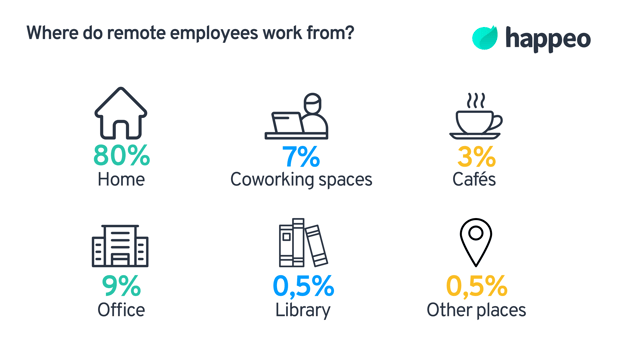

Remote work
7 challenges of working from home and how to overcome them

Jonathan Davies
23 mins read
Wed, Mar 1, '23
Working from home is on the rise. In fact, 70% of knowledge workers say that they’re happy with the amount of time that they work from home, as it offers them flexibility.
The trend of working from home has risen tremendously in the United States – from 3.4% before the pandemic to 42% working from home full-time mid-pandemic.
No matter how hard your employees work, there are bound to be some obstacles and challenges of working from home as shown by a study from Buffer. For 20% of the employees, collaborating remotely is the biggest obstacle, while another 20% see loneliness as the biggest problem. 18% find it hard to make a clear distinction between working and personal time.
.png)
7 challenges of working from home (and how to solve them)
Challenge #1 Distractions in the home office
When people hear "working remotely" they immediately think of "home office". 80% of remote employees work from home, while only 7% use co-working spaces and 3% use coffee shops. When employees work from home, distractions make it all too easy to get sidetracked. Household chores and family obligations have the biggest potential to take away employees' focus, while other people are tempted by social media apps. Phones and other devices might be essential tools for work, but they can also cause some serious distractions. These distractions result in higher levels of stress and decreased productivity.
Solution 1: Designate a workspace
A designated work area is extremely important to avoid home office distractions. Setting up a home office is a whole process, and we’re here to break it down for you:
- Organize a dedicated desk in a quiet area in the house. Don’t work from the couch – we know that it has an alluring aura to it, but it’s a trap.
- Clean up and organize your computer. If you can describe your workstation as a cluttered desktop or a browser with 15+ tabs open, it’s time to organize your computer. Digital minimalism, anyone?
- Bring items from the office to help create an environment that resembles your usual working spot.
- Don’t use your home office when you aren’t working – this spot is reserved only for work-related tasks.
Solution 2: Invest in home office inventory
One of the best tips to help your employees eliminate distractions at their home office is to ensure they work in an environment that encourages them to give their best. Get to know what they’re missing for a fully equipped home office setting. Provide them with the tools they normally use at the office, and if needed – with ergonomic home office equipment. Make sure that they have a chair suitable for an eight-hour working day or an ergonomic mouse pad. By supporting employees with home office inventory you contribute to the creation of a space similar to an actual office, which decreases distractions and boosts productivity.
Solution 3: Finance internet spending
Did you know that only 15% of employers cover the internet bill of their remote staff? Take the initiative and cover the monthly internet connection expenses of your employees. This way you’ll make sure that their working process is not interrupted by internet-related issues and they can fully focus on their work.
How does a remote work software work?
Watch video
Challenge #2 Overworking
Remember the 18% we talked about earlier that work overtime? This one’s for them.
Since there’s no clear way to unplug at the end of the day, it can be challenging to separate work and personal tasks. Sometimes people find themselves checking and responding to emails late into the night. But when employees work from home too many hours without a break, they get overworked, which can seriously affect motivation or quality of work.
Solution 1: Encourage a healthy work-life balance
One of the best ways to contribute to employees’ work-life balance is to encourage them to take vacation time. Give your workaholics a little push, because sometimes they tend to forget about themselves — only 22% of remote workers took three weeks off in 2020, as opposed to the majority of them, who took even less vacation time.
To solve problems associated with overworking, encourage employees to set their working times in their calendars and not work outside of these hours, even if the task is small. This gives workers a chance to take care of themselves and rest as needed.
Solution 2: Introduce social breaks
Think of activities that can give your employees a little time to step away from their tasks and freshen up their minds. Our recommended solution is to organize online lunch and coffee sessions — a little creative break can recharge employees and act as a motivation boost.
Solution 3: Set up reminders to take breaks
Remind your employees to take breaks. Set up reminders, or simply install a reminder app like Stretchly or Eye Care 20 20 20.
Challenge #3 Loneliness and lack of interaction
Loneliness can become an issue when working from home long-term. Being away from an office full-time can be isolating, especially when workers are used to casual water cooler talk and spur-of-the-moment conversations among colleagues. As we already mentioned at the beginning, 20% of the employees recognize it as the biggest challenge of working from home. The lack of interaction can harm your company culture, as employees start feeling disconnected. That usually leads to a lack of employee engagement and dissatisfaction. If not addressed on time, it can easily result in an increased turnover rate.
Solution 1: Provide a way for employees to socialize
As a manager, you should recognize the importance of human connection and think of ways to let work-from-home employees reconnect. The answer: a social intranet. It goes a step further than a traditional intranet, and besides sharing updates and files, social features enable employees to like, share and comment on posts. To overcome loneliness, teams have developed groups in their social intranet platforms, where people can talk about their favorite sports teams or artists, or share funny content and bond. Creating a group chat for discussing topics unrelated to work is also an option.
Solution 2: Virtual conferences
Another tip is to let your employees set aside time and chat with other working professionals. Local networking opportunities and conferences also allow people in the same industry to come together in the same room. The good news: conferences are also available online and can be joined virtually. In case your employees feel disconnected, encourage them to reach out to other professionals in your community – they may be facing similar home office challenges.
Solution 3: Celebrate important events
Everyone loves holidays. And what better way to feel the togetherness and up the spirits than to organize a virtual celebration? There’s no better occasion to get creative with outfits than Halloween, while an online cook along for Thanksgiving or a Christmas get-together would spark joy among workers.
Challenge #4 Team collaboration and communication issues
When working from home, teamwork, collaboration, and communication among team members are key. But with so many channels for collaboration available, it can be difficult to choose the right remote work tool and to make a decision between the many platforms out there. Collaborating and communicating from distance make it difficult for teams to work together on projects and meet their objectives on time.
Solution 1: Provide cloud-based collaboration tools
Rolling out a social intranet is great for employee socialization and communication, but your team also needs robust collaboration tools. Even though employees work from home, the workflow needs to be maintained, and that can be hard if they don’t have the tools to collaborate.
Platforms like Google Workspace provide a safe and seamless way for team collaboration. With Google’s cloud-based productivity apps, everyone can work together on documents and presentations, or store and share files on Drive. Besides that, many companies ensure seamless collaboration and communication by choosing Google intranet software – an intranet that integrates seamlessly with Google Workspace. No internet connection? No problem – Google’s productivity tools offer offline editing.
Solution 2: Establish communication channels to collaborate and communicate easily
Team communication could include a messaging platform such as Slack to talk about issues in real time. Email can be utilized when a response is not necessary right away. Video calls are a good strategy for brainstorming solutions or when a longer conversation is required.
Solution 3: A digital workplace platform
Home offices are gaining in popularity as it gives employees a more flexible work environment. Companies are exploring the right technologies so they can properly manage and support teams. Happeo is the leading digital workplace platform that brings together knowledge management and internal communications in one place.
Discover all the features of a remote work software
Download list
Challenge #5 Lack of motivation during work
No matter your work ethic, it’s normal to feel unmotivated sometimes. It happens to everyone at some point in their career. The trick is not to let a lack of motivation get in the way of staying productive. Organizations should make daily or weekly check-ins a priority and invest in strong communication strategies. Employers should make an effort to understand the concerns that may lead to a lack of motivation in their teams.
Solution 1: Start the day on a positive note
Home office workers can also motivate themselves in a number of small ways. This means participating in any activity that gives you joy. Wake up in the morning a few minutes early and engage in a quick yoga session. Grab a cup of coffee and make breakfast before starting your task list.
Solution 2: Include gamification in your strategy
Another working-from-home tip is gamification, which is a workplace practice of adding game-like elements to work, like quizzes and competitions offering prizes to players for meeting their professional objectives. The trend helps drive employee motivation and adoption. It’s a great way to introduce updates to employees, especially when they’re doing home office and there’s no one around to help build engagement.
Solution 3: Establish a reward system
Everyone loves when their achievements get recognized, be it at the workplace or not – it acts as a great motivator and boosts employee satisfaction, especially in challenging times. Set KPIs and think of how to reward employees when they meet them. Bonuses, gift cards, or professional development coaching in the desired direction are always a good surprise.
Challenge #6 Inefficient time management
Time tracking is one of the biggest challenges of working from home, as employees often lose sense of time. Poor time management quickly becomes a problem for both the employee and the employer.
Solution 1: Implement Google Calendar
A regular routine will bring order to the workweek and give you enough time for all of your commitments. Google Calendar allows users to block off certain hours for projects and meetings to help with time management.
Home office employees often juggle many responsibilities at once. Google Calendar has useful features that can make managing a busy schedule much easier. Hey, even better – Google Calendar allows home office workers to plan meetings with people in different time zones easily – you can add and change time zones, as well as add world clocks to your calendar. This setting is a life-saver for individuals who travel frequently or if there is a large time difference between team members.
Solution 2: Make a checklist
Write down your to-do list for the week and separate tasks for every day. It’s truly school-like, but the basics never die. Scratching tasks off lists is always satisfying and motivating.
Challenge #7 Keeping a healthy lifestyle
A sedentary lifestyle can’t be healthy – sitting in one place for hours plus the temptation to sneak into the cupboards for junk food throughout the day creates another challenge to maintain a healthy work-from-home workforce.
So, how can home office workers stay healthy during work hours?
Solution 1: Support healthy eating
If company-paid lunches haven’t been part of your policy, now is the time to incorporate them. It doesn’t have to be every day – pick a day from the week when employees can order a meal from a provided list of restaurants serving healthy food. Establish a certain budget, and encourage them to order a healthy meal – healthy food makes a full difference between a fuzzy and a focused mind. They’ll appreciate the gesture, and feel more connected to an organization that makes their well-being a priority. Plus, that sounds like an occasion for a virtual lunch break :)
Solution 2: Facilitate sports activity
Set an extra budget aside and invest in a boot camp program. There are plenty of external companies that are dedicated to organizing those kinds of open-air courses. No need to mention the benefits that come along, such as fit and motivated employees. Go outside and enjoy a freshen-up session with colleagues. Time for team-building!
Want to see how Happeo helps your business?
Book a demo
Working from home is the new normal
Like every big change, switching from office to home office suggests some challenges throughout the process. By investing time and resources to overcome them and following our working-from-home tips, remote working can quickly become an enjoyable and preferred alternative.
If you are interested in unlocking the value of remote work, book a demo with Happeo. We can help you improve employee engagement, internal communications, and even productivity.








